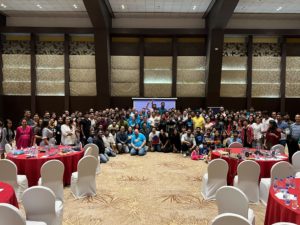We’ve previously discussed effective strategies you can employ when hiring software developers in India, as well as what to expect when offshoring your software development.
While these articles offer great resources that help hiring managers and executives identify what qualities to look for in these candidates, it’s also important to realize that the actual ins and outs of the screening and recruiting process are not as easy as you might think if you decide to hire software developer in India.
If you really want to dive into the realities of expanding your team offshore, here’s a behind-the-scenes look at some of the nuances and idiosyncrasies you’ll encounter in the process.
In India, the Equivalent of Two Weeks’ Notice is 90 Days
Most developers in India have at least a 60-day notice period they need to give their current employer before they can switch to another job. For others, that waiting period between jobs can be up to 90 days. So when an Indian software developer accepts an offer, they’re essentially putting in their notice and preparing to start a new job in 60 to 90 days.
But it gets even more complicated. Once they’ve put in their notice and initiated the 60-90 day waiting period, most candidates who have accepted an offer will use that time to explore other, possibly more competitive, offers from various employers.
So, just because a developer accepts your offer, it in no way guarantees that he or she will actually end up working for your company three months down the road.
This leaves recruiters with a few options:
- Attempt to keep candidates “warm”, or interested in committing to your company throughout that 90-day period, and hope they’ll join your team at the end. Or,
- Headhunt other potential candidates who are closer to the end of their waiting period, and entice them with a better offer than the company they originally signed with. (Pro tip: these candidates will almost always tag themselves as an “Immediate Joiner” on LinkedIn).
- Try to buy out the candidate’s notice period. Sometimes the candidate’s current employer will allow you to hand over two to three months’ pay to buy out the remainder of the candidate’s time with them.
As you can probably tell, the urgency behind recruiting top talent can create an ultra-competitive game of musical chairs. Throw in a two- to three- month waiting period, and you have hiring managers scrambling to fill their seats.
Increased Cost to Company (Like the Indian-Standard 30 Percent Pay Increase)
Adding skilled engineers to your software team isn’t an inexpensive undertaking, no matter where you hire them from. But when it comes to Indian software developers, in particular, you may end up paying more than you anticipated.
Every time a person in India changes jobs, he or she expects a 30 percent increase from their next employer, even if they’ve only held their current job for a year. A subset of those candidates expects an even bigger increase—sometimes 40 to 50 percent!
In addition to the 30 to 50 percent pay increase you will need to offer candidates, keep in mind the incurred cost of recruiting, screening, and hiring them as well. Recognize you may have to find several hirable candidates for one role to actually get one employed.
Other recruiting costs may include:
- A recruiter’s time to screen candidates
- Skill assessment tools like HackerEarth, CoderByte, or Codility to narrow down your pool of applicants
- Paid job posting pages like LinkedIn jobs, Cutshort, Stackoverflow, and many others
- Finding tools like LinkedIn Recruiter
Outside of those costs, you will need an applicant tracking system (if you don’t have one already) and to budget for social media marketing to ensure candidates can get a feel for your company’s culture.
Cultural Concerns You Might Not Have Expected
Employers also need to be aware of some cultural differences. For example, like U.S.-based developers, India-based developers place a high premium on autonomy and creative input; one of the main factors driving these developers away from an employment situation is feeling like they’re not being listened to, or that they’re being treated like a mindless robot.
The Other Kind of “Culture”
Similarly, one quality developers in India prize in a new employer is company culture. They frequently peruse the company’s website, Glassdoor, and LinkedIn to get a better picture of how the company treats its employees.
And while you can campaign to get your current employees to leave reviews on these platforms, working with a partner who has a foothold in both the U.S. and India can take the guesswork out of presenting your company in its best light to potential employees.
A Typical Hiring Scenario
Now that you understand some of the circumstances of hiring a software engineer in India, let’s look at how to navigate a typical hiring scenario.
Let’s say you’re looking for a Senior Ruby on Rails Developer or PHP Developer:
- The first thing to do is to examine all existing applicants in your pool. Sometimes the solution is right under your nose.
- If your existing talent pool can’t fill the position, post the job on your website. You should also leverage your applicant tracking system to post to Indeed, Monster, LinkedIn, and other job boards (using a tool to syndicate postings during this step will expedite this).
- Cutshort, Stack Overflow, and Naukri are also great places to post positions.
- We’ve found that 80 percent of candidates will apply through LinkedIn (however posting to a LinkedIn job slot can cost $500 per job each month).
- Start collecting resumes. If you have a high number of applicants, consider using a coding assessment to narrow your pool.
- Resumes mean almost nothing when vetting candidates; the real test of skill will come through a live coding interview.
- Screen developers who have passed the assessment through a (virtual) face-to-face call.
- Here is where you can talk about expected compensation, where they are in their waiting period, and where they’re based. You can ask technical questions to further test their knowledge. This is also a good time to identify what’s important to them in their next role so you know how to best persuade them to pick you after their waiting period ends.
- Next, have developers code for you. This will give you a chance to see their thought process and make sure they really know their stuff.
- In addition to their coding knowledge, you might also probe their philosophies on software architecture, team dynamics, etc.
- Once you’ve verified you are still okay to hire for your open role, work on an offer.
- Remember, Indian software developers are always looking for the best offer; typically what you’ve negotiated early is okay, but they may have found another company that’s offering more money, meaning you’ll need to start negotiations again.
- Extend the offer. If you’re at the end of the 90 days, awesome! If not, you need to weigh your options by either keeping them warm and selling them on company culture or finding someone who’s more readily available.
- Plan for your new hire’s technology needs. Ordering and shipping a laptop to a new hire is not as easy as it used to be; the Coronavirus pandemic has made the distribution of office equipment much more challenging.
- Think about ways to onboard your new hire if remote work is required.
Is an Indian Software Developer Right for You?
Even though the coronavirus outbreak has allowed for greater developer availability, the entire process from start to finish can take between four and five months and is always evolving as new developers enter the pool. In almost every case, the best solution is neither the cheapest nor the most readily available.
To establish a sustainable hiring strategy, particularly when it comes to hiring a software engineer in India, you really need to know how to navigate the timing, quality, and cultural issues that will inevitably come up.
Or, you can save yourself the time, energy, and added cost by partnering with a U.S.-based software development provider who has already built a global pool of highly talented software developers.







